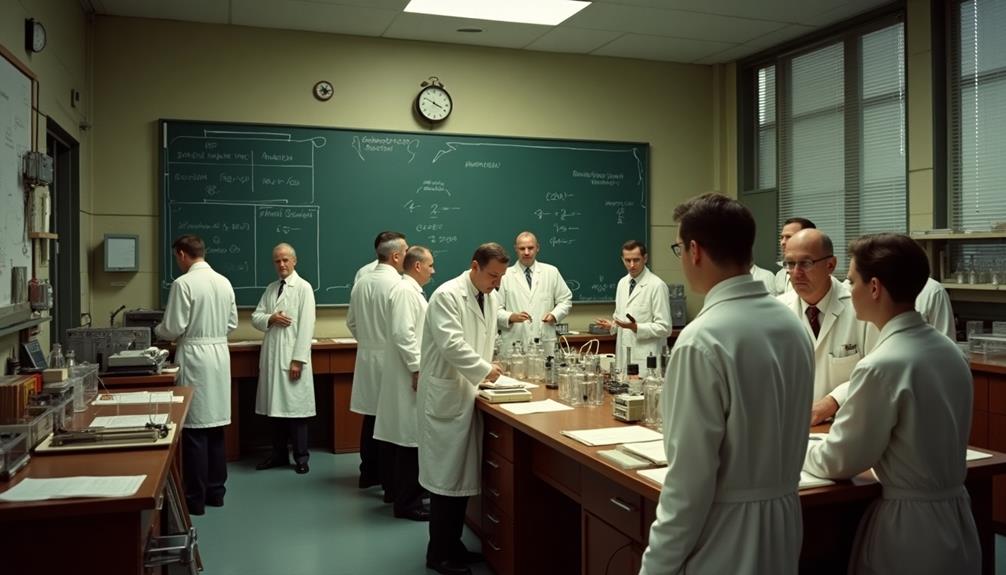The trajectory of scientific development in the USSR provides a compelling narrative of ambition and innovation amidst the backdrop of political change and ideological fervor. From the ambitious strides made following the Bolshevik Revolution to the unparalleled achievements during the Cold War, Soviet science not only shaped technological advancement but also fundamentally altered global perceptions of scientific expertise.
Introduction

Science served as a cornerstone for societal advancement in the USSR, driven by the state’s ambition to establish itself as a global superpower. During the Cold War era, Soviet innovations and technological advancements became instrumental in achieving this goal.
A chronological analysis reveals that the USSR invested heavily in Cold War science, particularly through the Space Race, marking milestones with Sputnik in 1957 and Yuri Gagarin’s 1961 orbit.
Primary sources highlight the government’s strategic focus on scientific collaboration, both domestically and internationally, to harness intellectual resources and bolster technological prowess.
These scientific endeavors not only projected Soviet strength but also aimed to elevate living standards and industrial capabilities, thereby intertwining science with the broader narrative of societal progress and geopolitical rivalry.
In the wake of the 1917 Bolshevik Revolution, scientific progress emerged as a critical component of the new regime’s agenda to reshape society and consolidate power.
The Soviet leadership emphasized scientific collaboration and technological innovation as tools to advance industrialization and improve living standards.
Historical Context
In the nascent years following the Russian Revolution, the Soviet government prioritized the elimination of illiteracy, implementing rapid educational reforms that markedly elevated literacy rates across the nation.
This period also witnessed the strategic establishment of over 30 research institutes between 1918 and 1919, laying the groundwork for a robust scientific infrastructure.
Literacy campaigns were launched, underpinned by extensive education policies that emphasized public engagement and accessibility. The Bolshevik government prioritized adult education as a means to cultivate an informed proletariat, integral to socialist ideology.
Archival documents reveal that by the early 1920s, teacher training programs were aggressively expanded to meet the demand for qualified instructors, particularly in rural areas.
The People’s Commissariat for Education orchestrated these efforts, establishing a chronological framework of initiatives that gradually permeated Soviet society.
Impact of Rapid Educational Reforms
Frequently hailed as one of the most transformative periods in Soviet history, the rapid educational reforms of the 1920s and 1930s dramatically altered the landscape of literacy across the USSR.
Spearheaded by state-driven educational policies, the reforms prioritized curriculum development aimed at fostering scientific literacy. Primary sources from this era reveal the breadth of literacy campaigns that were deployed, engaging the public in unprecedented ways.
Official decrees mandated widespread access to education, subsequently catalyzing a rise in literacy rates. Chronologically, these reforms were implemented in tandem with broader socio-economic shifts, aligning with the state’s vision of a literate, scientifically-minded populace.
The momentum generated by the educational reforms of the 1920s and 1930s naturally extended into the scientific domain, paving the way for the establishment of research institutes across the USSR.
These institutes were characterized by substantial Soviet funding, which facilitated significant technological innovation and research collaboration. Archival records reveal that the Soviet government prioritized science to enhance technological prowess and assert ideological dominance.
In the immediate aftermath of the Russian Revolution, the Soviet Union’s commitment to advancing scientific research became evident through the establishment of over 30 research institutes between 1918 and 1919.
These institutes marked a significant shift towards structured innovation policies, aiming to harness technological advancements for national development.
Primary sources from this era highlight the prioritization of scientific funding as a means to foster research collaborations, both domestically and internationally.
The newly formed institutes became hubs for international exchanges, facilitating the cross-pollination of ideas and methodologies.
This period laid the groundwork for a centralized scientific community, characterized by a coordinated approach to research and development.
Chronologically, these efforts underscored the USSR’s strategic focus on elevating its scientific prowess during a transformative historical moment.
Thousands of Institutes Open
By the time of the USSR’s dissolution in 1991, the Soviet scientific landscape had expanded dramatically, with the number of research institutes growing from the initial 30 to thousands.
This expansion was driven by strategic funding strategies aimed at fostering scientific collaboration and technological advancement. The USSR’s global influence in science was evident through its participation in international collaborations and technological rivalry with Western nations, especially the United States.
Primary sources reveal how Soviet policy implications prioritized scientific growth to bolster national prestige and technological prowess.
Chronologically, the Cold War era saw an intensified focus on research, resulting in a surge of institutes dedicated to various scientific disciplines.
This growth, however, faced challenges as economic constraints began to impact sustainability.
Growth of Scientific Workforce

The growth of the Soviet scientific workforce was a crucial element of the country’s development, marked by a significant rise in the number of scientists.Analysis of government reports and statistical data reveals that the scientific workforce exceeded one million by the end of the USSR. This increase, spanning from the post-war years to the late 20th century, highlights the state’s focus on scientific advancement as a key component of its socio-economic and geopolitical goals.
During a period of rapid industrialization and technological progress, the Soviet Union saw substantial growth in its scientific community throughout the 20th century. Archival records indicate that international collaboration was a priority, with increased participation in global conferences supported by strategic research funding aimed at fostering innovation across various fields, including environmental science.
The Soviet government understood the necessity of a strong scientific community to tackle complex challenges and promote progress. Historical documents show that this expansion began in the 1920s with efforts to establish research institutions and continued through the post-World War II era, where education and innovation became central priorities.
Popularization of Science in the USSR
The popularization of science in the USSR was significantly advanced through educational initiatives, including the publication of magazines like Knowledge is Power and Young Naturalist, which were essential for disseminating scientific knowledge.
Engagement Through Publications
Emerging in the mid-20th century, these magazines played a vital role in educational outreach, targeting youth to spark interest in scientific disciplines. Their engaging content and appealing design helped bridge the gap between complex scientific concepts and everyday understanding. By highlighting scientific advancements and practical experiments, these publications shaped cultural perceptions that valued scientific literacy as a societal cornerstone.
Community Involvement and Clubs
In addition to printed media, the establishment of free clubs and hobby groups further engaged youth in science. These initiatives, prominent during the mid-20th century, provided a platform for collaborative learning and hands-on experimentation. For example, the Pioneers’ Palaces, founded in the 1930s, became centers for scientific exploration where young people worked on projects ranging from model rocketry to biology.
Visual Campaigns for Science Promotion
The Soviet Union also effectively used visual campaigns to promote science. Posters became a key tool for public engagement, combining vibrant colors and compelling imagery to captivate audiences. Historical sources indicate that this approach was prevalent from the 1920s through the 1980s, evolving alongside scientific advancements.These campaigns harnessed art to enhance public understanding and foster scientific literacy. Primary sources from the 1950s and 1960s reveal that meticulously crafted posters, films, and exhibitions were designed to educate and inspire curiosity among the populace.
This approach not only democratized knowledge but also cultivated an informed citizenry, aligned with the state’s scientific aspirations.
Achievements in Soviet Science

The Soviet Union’s scientific achievements were particularly pronounced in key fields such as physics, chemistry, and biology, with significant advancements that reshaped global scientific paradigms.
Primary sources from the era highlight groundbreaking contributions, including the development of nuclear physics and the historic milestones of the space race, such as the launch of Sputnik in 1957 and Yuri Gagarin’s orbital flight in 1961.
Pioneering advancements in various scientific fields marked the Soviet Union’s prominent role in 20th-century science and technology. Early genetic research, despite the controversial Lysenkoism period, laid groundwork for future explorations.
The 1950s and 1960s saw substantial progress in environmental science, aligning with global ecological awareness. Concurrently, agricultural innovation thrived, particularly through mechanization and crop improvement, reflecting the state’s emphasis on self-sufficiency.
The 1960s also witnessed breakthroughs in computer technology, exemplified by the development of the BESM series, which contributed to Soviet computing prowess.
In Soviet science, notable achievements in physics, chemistry, and biology reflect the state’s focused investment and strategic planning. State funding fueled technological innovation, fostering breakthroughs from the late 1940s onward.
In physics, research into nuclear energy was pivotal, showcasing how state-directed initiatives could yield transformative technologies.
Chemistry saw Soviet scientists excel in polymer research, contributing markedly to industrial applications.
Soviet biology progressed through studies in genetics and microbiology, despite political challenges affecting some research areas.
Scientific collaboration was encouraged, both domestically and with international counterparts, enhancing the USSR’s global scientific standing.
Primary sources from the era reveal how Soviet state policy prioritized research areas to bolster both technological prowess and international relations.
This strategic approach underpinned the USSR’s scientific advancements.
Notable Scientific Contributions
Soviet scientific contributions emerged as a demonstration to the nation’s strategic focus on research and innovation. From the mid-20th century onwards, the USSR made remarkable strides in space exploration, especially collaborating on projects that expanded humanity’s understanding of the cosmos.
Technological innovation was another hallmark, with Soviet scientists pioneering advancements in computing and telecommunications that had global implications. Environmental science also saw considerable development, with Soviet researchers contributing to ecological studies and sustainable practices.
The period was marked by robust scientific collaboration, both domestically and internationally, reflecting a commitment to shared knowledge. In the domain of medicine, the USSR achieved significant medical advancements, including innovative approaches to disease prevention and healthcare delivery, greatly improving public health outcomes in the region.
Nuclear Physics and Space Exploration
The mid-20th century marked a transformative era in scientific advancement, particularly in the domains of nuclear physics and space exploration. The USSR’s nuclear energy program, initiated in the 1940s, signaled a new epoch of scientific innovation, as evidenced by the successful detonation of the RDS-1 in 1949. This achievement intensified the technological rivalry with the West.
Concurrently, the USSR propelled ahead in the space race, launching Sputnik in 1957, the first artificial satellite. Primary sources reveal that the Soviet leadership viewed cosmic exploration as a demonstration of their scientific prowess.
Institutional Framework

The institutional framework of Soviet science was chiefly anchored by the Academy of Sciences of the Soviet Union, established as a pivotal entity for advancing scientific research throughout the USSR.
Emphasizing the integration of scientific endeavors with national objectives, the Academy’s structure was meticulously designed to align research initiatives with the broader societal goals articulated by the state.
This alignment, as evidenced through primary source documents from the era, underscored a strategic chronology where scientific progress was not only measured by innovation but also by its capacity to serve the overarching priorities of the Soviet regime.
Academy of Sciences of the Soviet Union
Established in 1724, the Academy of Sciences of the Soviet Union served as the pinnacle of scientific achievement and research within the USSR’s institutional framework.
Soviet scientists, who worked under this prominent institution, were pivotal during the Cold War era, where technological rivalry with the West intensified. The Academy’s influence was evident in its strategic allocation of science funding, which prioritized projects that would enhance Soviet prowess, from space exploration to nuclear technology.
From its inception, the Academy fostered scientific collaboration, aligning with public policy to drive technological innovation. Archival documents reveal its strategic role in addressing ethical considerations within scientific endeavors, ensuring responsible progress.
Throughout the Cold War era, the Academy became a pivotal player in international competition, channeling resources to bolster the USSR’s scientific standing.
Chronologically, the institutional structure evolved to integrate diverse research institutes, each contributing to a cohesive system that underpinned the Soviet Union’s formidable scientific achievements.
Coordination with National Objectives
In the intricate tapestry of Soviet governance, coordination with national objectives was paramount, as evidenced by the centralized institutional framework of the Academy of Sciences of the USSR.
The science policy was meticulously crafted to align research with state priorities, fostering technological innovation while considering ethical implications.
Historical records reveal that funding strategies were tightly controlled to guarantee alignment with political goals, as seen in primary documents from the 1950s and 1960s.
International collaboration was selectively pursued, allowing Soviet scientists to engage globally while safeguarding ideological tenets.
The centralized coordination of Soviet scientific endeavors naturally extended into the integration of scientific institutions with broader societal goals.
From the 1920s onwards, Soviet science policy emphasized aligning research collaboration with national priorities, enhancing societal impact through technological innovation.
Historical records reveal that state mandates drove scientific progress, ensuring that research institutions contributed directly to economic and social objectives.
Primary sources, such as government decrees and institutional reports, highlight the era’s focus on public engagement, underlining science’s role in addressing societal needs.
The chronological framework from Lenin’s era to the late Soviet period demonstrates evolving strategies, with a constant emphasis on aligning science with ideology.
This integration fostered a unique synergy between scientific advancement and state-driven goals, influencing global perceptions of Soviet science.
Challenges Faced by Soviet Science

Soviet science’s struggle with resource allocation emerged as a critical challenge that shaped its development throughout the 20th century. Initially, Lenin’s regime prioritized rapid industrialization, influencing resource distribution towards applied sciences.
However, budget constraints often resulted in uneven research allocation. Primary sources reveal that funding priorities were skewed towards military and space technologies, leaving basic sciences underfunded.
In the 1930s, Stalin’s centralized planning intensified this issue, as scientific investments focused heavily on projects with immediate state utility.
Post-World War II, the Cold War prompted shifts in funding priorities, with increased investments in nuclear research.
Despite these efforts, chronic budget constraints persisted, affecting the sustainability and breadth of Soviet scientific endeavors. This allocation dilemma profoundly impacted Soviet scientific achievements and international standing.
Management within Scientific Institutions
Maneuvering the labyrinthine landscape of funding and resource management within Soviet scientific institutions posed significant challenges throughout the 20th century.
Historical documents reveal persistent funding disparities across disciplines, often dictated by shifting institutional priorities. The centralized planning model emphasized strategic areas, such as military and space research, leading to uneven resource allocation.
Bureaucratic challenges further compounded these issues, as scientists navigated intricate administrative hierarchies to secure necessary support. Archival records from the 1960s and 1970s illustrate how these constraints stifled innovation, particularly in fields deemed less critical.
Primary sources from the era illustrate collaboration barriers, as the Cold War environment restricted international scientific exchange, isolating Soviet researchers from global advancements.
The cumulative effect of these factors was innovation suppression, as brilliant minds were redirected to state-sanctioned tasks, leaving many groundbreaking ideas unexplored or abandoned.
Throughout the Soviet era, science served as a vital catalyst for technological and industrial advancement, underpinning the USSR’s status as a global superpower.
Analyzing primary sources from this period reveals a legacy of scientific innovation that persists in shaping contemporary research and development, particularly in fields such as space exploration and nuclear physics.
The role of science as a driver for progress in the USSR was both pivotal and multifaceted, considerably shaping the nation’s trajectory throughout the 20th century.
The USSR’s science policy emphasized state-driven initiatives that spurred technological advancements, particularly in space exploration and nuclear energy.
As the curtain fell on the Soviet Union, its scientific legacy endured, leaving an indelible mark on contemporary scientific endeavors worldwide.
Soviet innovation, from space exploration to nuclear technology, established a technological legacy that remains a benchmark. Historical comparison reveals the USSR’s global impact, as its advancements inspired international collaborations and competitive progress in the West.
Primary sources, such as archival documents, highlight a complex interplay of scientific ethics and state-driven objectives that continue to influence modern research paradigms.
Within a chronological framework, Soviet achievements in fields like physics and mathematics laid foundational principles still applied today.
Understanding this legacy offers insights into the evolving nature of global scientific inquiry, underscoring the importance of innovation tempered by ethical considerations.




